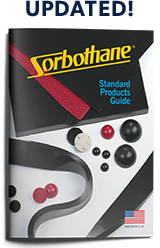What is a Good Material That’s Used for Noise Damping?
Noise is unwanted sound—and it is all around us. Some noises you perceive to be merely annoying. These might include noise produced by: the spin cycle of your washing machine, the blender that’s making your smoothie, the power tools that are being used out in the garage, your son’s stereo playing in the next room, or your daughter’s trumpet practicing in the basement. Noise can also be harmful. Such is the case if you are working near a high level noise source, especially for extended periods of time. Such scenarios might include: heavy machinery—such as stamping machines, punch presses, or sheeters; industrial equipment—including bulldozers, cranes, or stump grinders; and pneumatic tools—such as jackhammers or nail guns. Continuous exposure to high level noise, as well as repeated exposure to impact noise, can both result in hearing loss—even if you only believe the noise to be annoying. This noise, these unwanted sounds, need to be controlled.
Why control noise?
The most compelling reason for noise control is the threat of hearing loss. According to the National Institute of Occupational Safety and Health (NIOSH), hearing loss is the most common work-related illness. Nearly 22 million Americans are exposed to noise hazards annually. It is estimated that hearing loss disability costs the U.S. over $240 million per year. OSHA, the Occupational Safety and Health Administration, has responded to this threat by setting standards regarding workplace noise exposure. The OSHA PEL (permissible exposure limit) is 90dBA (decibels measured on the A Scale) as an 8 hour TWA (time-weighted average). This means that the worst allowable situation exists when a worker is exposed to a 90dB sound for 8 continuous hours. If the noise level exceeds the TWA of 90dB, it must be reduced–by limiting exposure time or by lowering the sound’s decibel level. In the workplace, reducing exposure time is not always possible without negatively impacting production. You must find a way to control the noise. To accomplish this, you need to ask—just what is a good material that’s used for noise damping? Sorbothane® is the most efficient noise damping material on the market.
What is Sorbothane and how does it provide noise damping?
Sorbothane is a unique proprietary viscoelastic polymer. Viscoelastic means that Sorbothane exhibits properties of both liquids (viscous solutions—ones that can flow) and solids (elastic materials). Sorbothane flows like a liquid when it is under a load (ex. sound wave vibrations). It acts like an elastic solid by returning to its original shape after forces are removed. Unique to viscoelastic materials, Sorbothane safely disperses absorbed energy (from noise) outward from the source of impact in the form of heat, protecting workers and machinery. It stands up to the wide range of temperatures found in the workplace without degrading or losing its effectiveness. What is a good material that’s used for noise damping? Sorbothane is specified by engineers worldwide for its noise damping properties—its ability to decrease the amplitude (intensity level) of the noise, as well as change the frequency (pitch) of the sound to avoid harmful or unwanted frequencies–such as those most associated with hearing loss.
Sorbothane off-the-shelf products and customization
Sorbothane’s line includes standard products that will effectively damp noise. Our Sorbothane Bushings and Washers are essential for damping noise.in machinery. To meet your specific sound damping needs, Sorbothane Strips and Sheet Stock are offered. Application of these products can eliminate noise due to metal on metal contact in equipment. Quieter designs result for consumer appliances and audio equipment when Sorbothane is incorporated into the product or when mounted on Sorbothane Hemispheres. When used to line the walls of practice rooms and recording studios, Sorbothane can provide superior noise control. Customization is also available by contacting our engineering staff.
Contact Sorbothane for further information on our standard products or to find out how our engineers can work with you to develop a unique solution.
